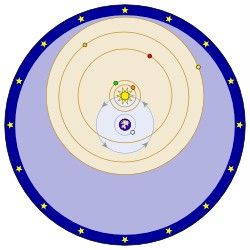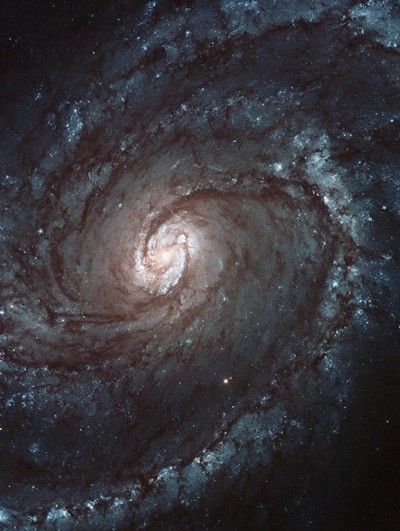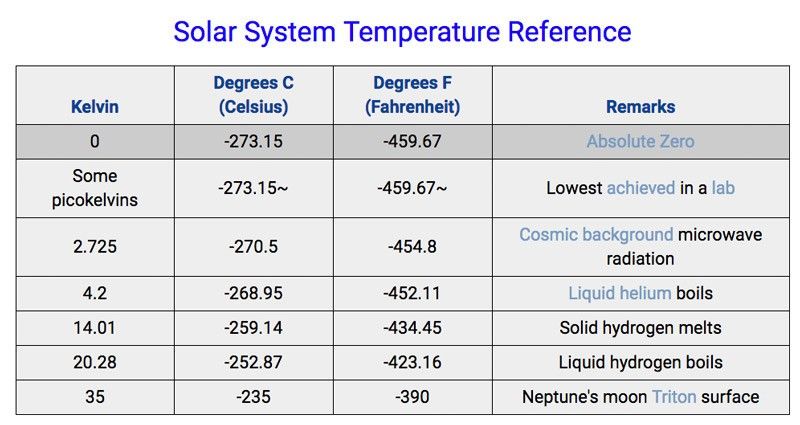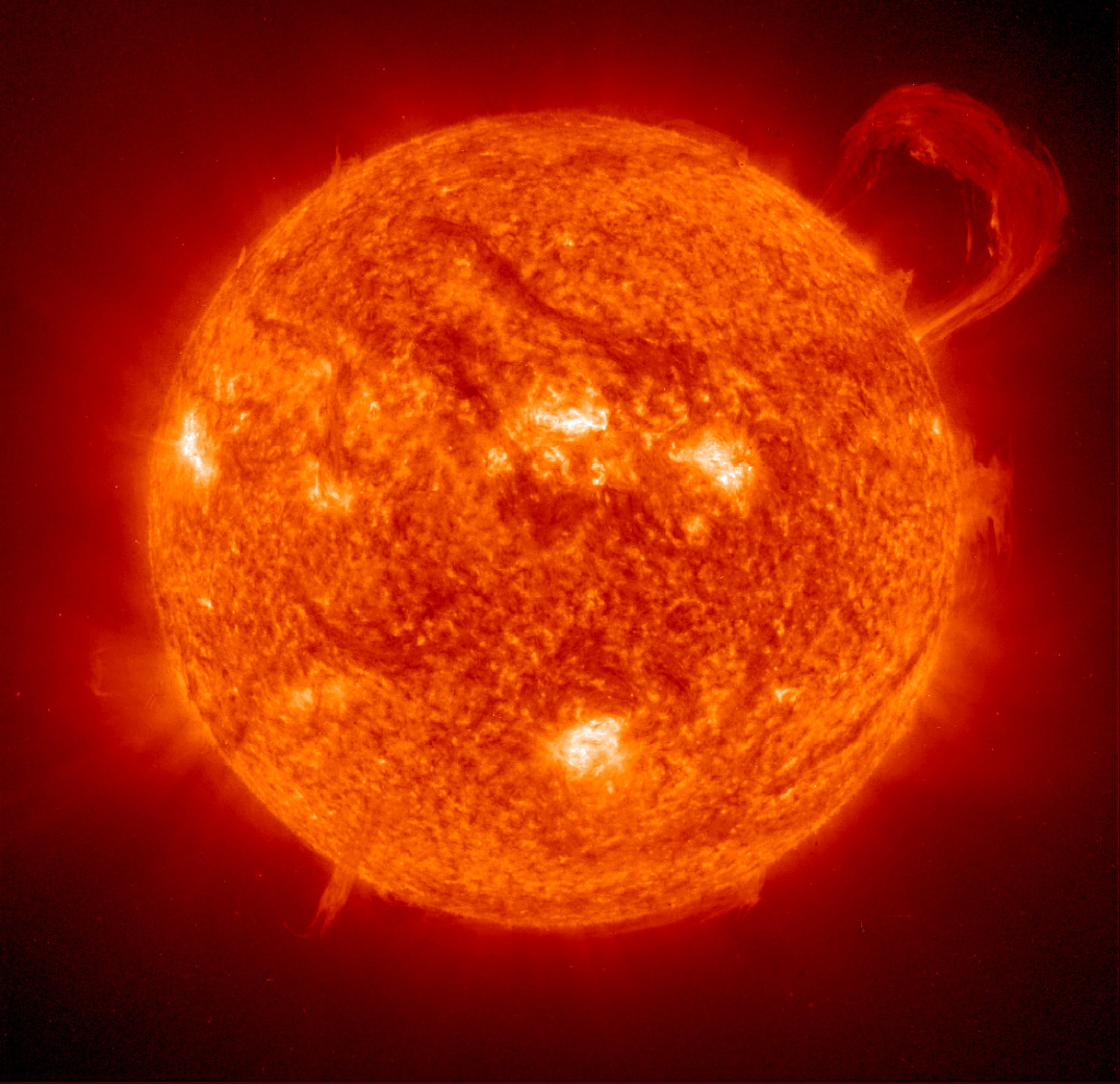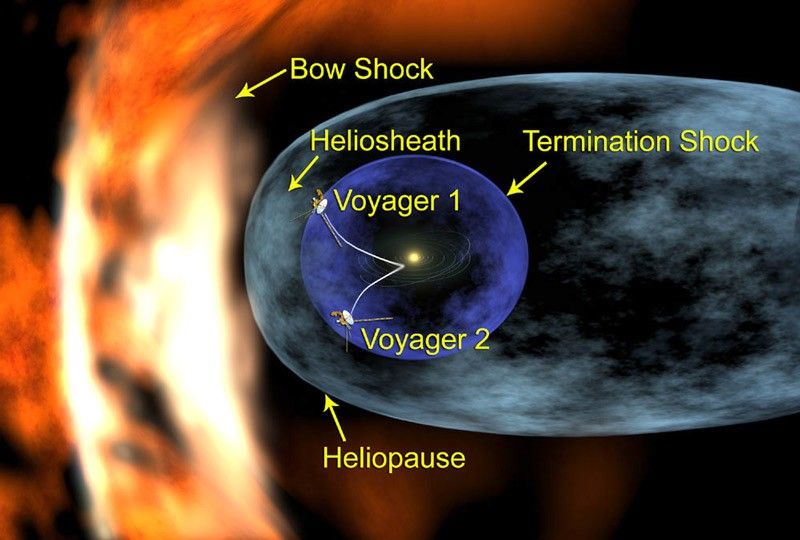Chapter 1: The Solar System
Contents
- Chapter Objectives
- Knowledge of the Solar System
- In Cosmic Perspective
- Approximate Typical Conditions in Galaxy
- Motions Within the Solar System
- Distances Within the Solar System
- Light Time
- Temperatures Within the Solar System
- The Sun
- Mass Distribution Within the Solar System
- Our Bubble of Interplanetary Space
Page One | Page Two | Page Three
Chapter Objectives
Upon completion of this chapter, you will be able to classify objects within the solar system, state their distances of in terms of light-time, describe the Sun as a typical star, relate its share of the mass within the solar system, and compare the terrestrial and Jovian planets. You will be able to distinguish between inferior and superior planets, classical and dwarf planets, describe asteroids, comets, the Kuiper belt, and the Oort cloud. You will be able to describe the environment in which the solar system resides.
Knowledge of the Solar System
The solar system has been a topic of study from the beginning of history. For nearly all that time, people have had to rely on long-range and indirect measurements of its objects. For all of human history and pre-history, observations were based on visible light. Then in the 20th century, people discovered how to use additional parts of the spectrum. Radio waves, received here on Earth, have been used since 1931 to investigate celestial objects. Starting with the emergence of space flight in 1957, instruments operating above Earth's obscuring atmosphere could take advantage not only of light and radio, but virtually the whole spectrum (the electromagnetic spectrum is the subject of Chapter 6). At last, with interplanetary travel, instruments can be carried to many solar system objects, to measure their physical properties and dynamics directly and at very close range. In the 21st century, knowledge of the solar system is advancing at an unprecedented rate.
The solar system consists of an average star we call the Sun, its "bubble" the heliosphere, which is made of the particles and magnetic field emanating from the Sun - the interplanetary medium - and objects that orbit the Sun: from as close as the planet Mercury all the way out to comets almost a light-year away. A light year is the distance light travels in a year, moving at about 300,000 km per second.
Objects that orbit the Sun are given many names and classifications, some of which overlap. The planets Mercury, Venus, Earth, Mars, Jupiter, and Saturn were known to the ancients (though Earth itself may not have been recognized as a planet until Nicolaus Copernicus's publication in 1543). The planets Uranus and Neptune, visible only with telescopic aid, weren't discovered until 1781 and 1846, respectively. Many of the planets have their own retinue of diverse satellites or moons.
In 1801, when an object was discovered orbiting the Sun between Mars and Jupiter, it was heralded as a new planet. Shortly thereafter, though, many more such objects were discovered in the same region, so the classification "asteroid" or "minor planet" became appropriate. There are many classes of asteroids, as you will see later in this chapter.
The four inner planets are known to be rocky, and they are classified as terrestrial planets. The four outer planets Jupiter, Saturn, Uranus, and Neptune, are gas giants - largely hydrogen and some helium, with small solid cores. They're also called Jovian planets.
In 1930, an object was discovered orbiting the Sun beyond Neptune; it was named Pluto. Its highly elliptical orbit was found to be inclined an unprecedented 17 degrees from the ecliptic. Like the first asteroid, it was heralded as a new planet. Fast-forward to the age of powerful new telescopes, and we learn that Pluto was only the first of many such objects to be discovered in that region of space. So, in 2006, the International Astronomical Union undertook to define the term planet for the first time. Pluto was redefined as one of five dwarf planets, another of which is Ceres, the first-seen asteroid.
Of the objects orbiting the Sun beyond Neptune, called Trans-Neptunian Objects, TNO, Pluto and the three other other dwarf planets (known as of early 2013) in that realm are called plutoids. They are: Haumea, Makemake and Eris. These, and many other bodies, are members of the vast Kuiper Belt.
Composed of material left over after the formation of the other planets (see comets in a later section), Kuiper Belt Objects (KBO) were never exposed to the higher temperatures and solar radiation levels of the inner solar system. They remain as a sample of the primordial material that set the stage for the evolution of the solar system as it exists today, including life. The New Horizons Spacecraft flew by Pluto in 2015. The fast flyby successfully returned data across the 4,800 million kilometers to Earth, revealing the extraordinary nature of the Pluto system.
The discovery of a TNO known as Sedna, which is smaller than Pluto, was of great scientific interest because of its very distant and highly elongated orbit. The closest it comes to the Sun, 76.4 AU (an astronomical unit, au, represents the distance between the Earth and Sun; see below) is more than twice Neptune's distance. Sedna is currently outbound in its 12,000-year orbit to a high point of 961 AU from the Sun. Understanding the genesis of its unusual orbit is likely to yield valuable information about the origin and early evolution of the Solar System. Some astronomers consider that it may be the first known member of the Oort cloud.
The Oort cloud is a hypothesized spherical reservoir of comet nuclei, the bulk of which would orbit roughly 50,000 AU - nearly a light-year - from the Sun. No confirmed direct observations of the Oort cloud have been made yet, but astronomers believe that it is the source of all long-period comets that enter the inner Solar System when their orbits are disturbed.
In Cosmic Perspective
Interstellar space is the term given to the space between stars within the galaxy. The Sun's nearest known stellar neighbor is a red dwarf star called Proxima Centauri, at a distance of about 4.2 light years. We are beginning to find that many stars besides the Sun harbor their own solar systems with planets, which are being called extrasolar planets, or exoplanets.The first exoplanet was discovered in 1992, and the milestone of 500 exoplanets known came in early 2011. Most are relatively nearby, within 5,000 light years, although one candidate was discovered in September 2005 via "microlensing" at a distance of 17,000 light years.
Our whole solar system, along with all the local stars you can see on a clear dark night, reside in one of our galaxy's spiral arms, known as the Orion arm, as they orbit the supermassive black hole in the dense star cluster at the center of our galaxy some 26,000 (±1400) light-years distant from us. At this great distance, we go around once about every 250 million years. Stars very close to the central mass are observed in keplerian orbits with periods as short as 15.2 years. This spiral disk that we call the Milky Way includes some 200 billion stars, thousands of gigantic clouds of gas and dust, and enormous quantities of mysterious dark matter.
The Milky Way has two small galaxies orbiting it nearby, which are visible from Earth's southern hemisphere. They are called the Large Magellanic Cloud and the Small Magellanic Cloud.
Our whole solar system, along with all the local stars you can see on a clear dark night, reside in one of our galaxy's spiral arms, known as the Orion arm, as they orbit the supermassive black hole in the dense star cluster at the center of our galaxy some 26,000 (±1400) light-years distant from us. At this great distance, we go around once about every 250 million years. Stars very close to the central mass are observed in keplerian orbits with periods as short as 15.2 years. This spiral disk that we call the Milky Way includes some 200 billion stars, thousands of gigantic clouds of gas and dust, and enormous quantities of mysterious dark matter.
The Milky Way has two small galaxies orbiting it nearby, which are visible from Earth's southern hemisphere. They are called the Large Magellanic Cloud and the Small Magellanic Cloud.
Our galaxy, one of billions of galaxies known, is traveling through intergalactic space. On a cosmic scale, all galaxies are generally receding from each other, although those relatively close together may exhibit additional local motion toward or away from each other as well.
Aside from its galactic orbital velocity (250-300 km/second), the Sun and its planetary system wander through the local stellar neighborhood at roughly 100,000 kilometers per hour, entering and leaving various tenuous local clouds of gas on a time scale of roughly once every few thousand to millions of years.
Immediately surrounding our solar system is a warm, partly ionized cloud, called the Local Interstellar Cloud. Like most interstellar clouds, its gas comprises about 90 percent hydrogen and 10 percent helium. Roughly 1 percent of the cloud's mass is dust.
Approximate Typical Conditions in Galaxy
| Region of Interstellar Space Within our Galaxy | Number Density, Atoms / cm3 | Temperature,* Kelvins |
|---|---|---|
| Inside our Heliosphere, in the Vicinity of Earth | 5 | 10,000 |
| Local Cloud Surrounding our Heliosphere | 0.3 | 7,000 |
| Nearby Void (Local Bubble) | < 0.001 | 1,000,000 |
| Typical Star-Forming Cloud | >1,000 | 100 |
| Best Laboratory Vacuum | 1000 | |
| Classroom Atmosphere | 2.7 X 1019 | 288 |
| * Temperatures refer to particles in the near-vacuum of space. Large physical masses, such as spacecraft, asteroids, etc., are not affected by the particles' temperature. Instead, the thermal states of massive objects are dominated by solar (or stellar) heating and exposure to shadow. | ||
| Outside the galaxy, in intergalactic space, the number density of particles is thought to fall off to about one atom or molecule per cubic meter (10-6 / cm3). | ||
Motions Within the Solar System
This animation shows the evolution of a planet-forming disk around a star. Initially, the young disk is bright and thick with dust, providing raw materials for building planets. In the first 10 million years or so, gaps appear within the disk as newborn planets coalesce out of the dust, clearing out a path.
The Sun and planets each rotate on their axes. Because they formed from the same rotating disk, the planets, most of their satellites, and the asteroids, all revolve around the Sun in the same direction as the Sun rotates, and in nearly circular orbits. The planets orbit the Sun in or near the same plane, called the ecliptic (because it is where eclipses occur). Originally regarded as the ninth planet, Pluto always seemed a special case in that its orbit is highly inclined (by 17 degrees) and highly elliptical. Today we recognize it as a dwarf planet, as well as a member of the Kuiper Belt. Most planets rotate in or near the plane in which they orbit the Sun, again because they formed, rotating, out of the same dust ring. The exception, Uranus, must have suffered a whopping collision that set it rotating on its side.
Distances Within the Solar System
The most commonly used unit of measurement for distances within the solar system is the astronomical unit (AU). The AU is based on the mean distance from the Sun to Earth, roughly 150,000,000 km. NASA's Deep Space Network refined the precise value of the AU in the 1960s by obtaining radar echoes from Venus. This measurement was important since spacecraft navigation depends on accurate knowledge of the au. Another way to indicate distances within the solar system is terms of light time, which is the distance light travels in a unit of time. Distances within the solar system, while vast compared to our travels on Earth's surface, are comparatively small-scale in astronomical terms. For reference, Proxima Centauri, the nearest star at about 4.2 light years away, is about 265,000 AU from the Sun.
Light Time
| Light Time | Approximate Distance | Example |
|---|---|---|
| 3 seconds | 900,000 km | ~ Earth-Moon Round Trip |
| 3 minutes | 54,000,000 km | ~ Sun to Mercury |
| 8.3 minutes | 149,600,000 km | Sun to Earth (1 au) |
| 1 hour | 1,000,000,000 km | ~ 1.5 x Sun-Jupiter Distance |
| 17 hours | 123 au | Voyager-1 (December, 2012) |
| 1 year | ~ 63,000 au | Light Year |
| 4.2 years | ~ 265,000 au | Next closest star |
Temperatures Within the Solar System
The temperature of planets and other objects in the solar system is generally higher near the Sun and colder as you move toward the outer reaches of the solar system. The temperature of low-density plasma (charged particles in the environment), though, is typically high, in the range of thousands of degrees (see "Our Bubble of Interplanetary Space" below).
Here is a table called the Solar System Temperature Reference. It shows examples and compares temperatures of objects and conditions from absolute zero through planet temperatures, to those of stars and beyond. Click the thumbnail to see the table. It also includes temperature conversion factors and links to a conversion engine.
The Sun
The Sun is a typical star. Its spectral classification is "G2 V." The G2 part basically means it's a yellow-white star, and the roman numeral V means it's a "main sequence" dwarf star (by far the most common) as opposed to supergiant, or sub-dwarf, etc.
The fact that the Sun is the dominant source of energy for processes on Earth that sustain us makes it a subject of major interest for study. As viewed from Earth's surface, the Sun subtends roughly half a degree of arc upon the sky (as does the Moon, at this period in the solar system's history.)
You can view some remarkable current images of the Sun as seen today by the suite of instruments aboard the Solar & Heliospheric Observatory (SOHO) spacecraft as it views the Sun from the L1 Lagrange point between the Earth and the Sun.
The STEREO pair of spacecraft provide the means to study the Sun in three dimensions. One spacecraft moves ahead of the Earth in solar orbit, and is named STEREO-A; the other, STEREO-B, lags behind Earth.
Mass: Because of its enormous mass, the Sun dominates the gravitational field of the solar system. The motion of everything within a few light years of the Sun is dominated by the effect of the solar mass. At 1.98892 X 1030 kilograms, or roughly 333,000 times the mass of the Earth, it contains over 99 percent of the solar system's mass. The planets, which condensed out of the same disk of material that formed the Sun, contain just over a tenth of a percent the mass of the solar system.
Mass Distribution Within the Solar System
| 99.85 percent | Sun |
| 0.135 percent | The Eight Classical Planets |
| 0.015 percent | Comets Kuiper belt objects Satellites of the planets Dwarf Planets Asteroids Meteoroids Interplanetary Medium |
| Even though the planets make up only a small portion of the solar system's mass, they do retain the vast majority of the solar system's angular momentum. This storehouse of momentum can be utilized by interplanetary spacecraft on so-called gravity-assist trajectories. | |
Fusion: The Sun's gravity creates extreme pressures and temperatures within its core, sustaining a thermonuclear reaction fusing hydrogen nuclei and producing helium nuclei. This reaction converts about 4 billion kilograms of mass to energy every second. This yields tremendous amounts of energy, causing the state of all the Sun's material to be plasma and gas. These thermonuclear reactions began about 5 billion years ago in the Sun, and will probably continue for another 5 billion years into the future. Energy produced in the core takes over a million years to reach the surface and be radiated as light and heat. Our star's output varies slightly over an 11-year cycle, during which the number of Sunspots changes.
Solar sound waves are mostly trapped inside the Sun. They refract away from the hot core, and reflect back and forth between different parts of the photosphere. By monitoring the Sun's vibrating surface, helioseismologists can probe the stellar interior in much the same way that geologists use seismic waves from earthquakes to probe the inside of our planet.
Rotation: The Sun rotates on its axis with a period of approximately 25.4 days. This is the adopted value at 16° latitude. Because the Sun is a gaseous body, not all its material rotates together. Solar matter at very high latitudes takes over 30 days to complete a rotation.
The Sun's axis is tilted about 7.25 degrees to the plane of the Earth's orbit, so we see a little more of the Sun's northern polar region each September and more of its southern region in March.
Magnetic Field: Magnetism is produced in the Sun by the flow of electrically charged particles: ions and electrons. Sunspots are somewhat cooler places seen on the photosphere (the Sun's bright surface) where very intense magnetic lines of force break through. Prominences that seem to float above the photosphere are supported by, and threaded through with, magnetic fields. All the streamers and loops seen in the corona (the Sun's extended upper atmosphere) are shaped by magnetic fields. Magnetic fields are at the root of virtually every feature observed on and above the Sun.
Not surprising, the Sun's magnetic field permeates interplanetary space. The magnetic field of the Sun influences the way in which charged particles (cosmic rays, solar energetic particles, and even interstellar dust grains) move through the heliosphere.
The 11-year solar magnetic cycle that Sunspot activity follows, is part of a 22-year "Hale" cycle. During the first half of the 22-year cycle, the Sun's magnetic north pole is in the northern hemisphere, while the magnetic south pole is in the southern hemisphere. Right around the peak of the Sunspot cycle (solar maximum) about 11 years into the magnetic cycle, the magnetic poles flip, exchanging places, so that magnetic north is then located in the southern hemisphere.
Mass Ejections: Coronal mass ejections, CMEs, are huge magnetic bubbles of plasma that expand away from the Sun at speeds as high as 2000 km per second. A single CME can carry up to ten billion tons (1013 kilograms) of plasma away from the Sun. Coronal mass ejections were once thought to be initiated by solar flares. Although some are accompanied by flares, it is now known that most CMEs are not associated with flares.
When a CME arrives at Earth, it can cause fluctuations in the Earth's magnetic field that can play havoc with the civil electrical power distribution infrastructure, by inducing unwanted voltages.
Solar Wind: The solar wind streams off of the Sun in all directions. The source of the solar wind is the Sun's hot corona, whose temperature is so high that the Sun's gravity cannot hold on to the material. Although why this happens is understood, the details about how, and exactly where, the coronal gases are accelerated is one subject of ongoing investigation. The solar wind flows fastest when the Sunspot cycle is at its minimum, because there is less turbulence in the corona to slow it down. Discussion of the solar wind's effects continues below.
Our Bubble of Interplanetary Space
The "vacuum" of interplanetary space includes copious amounts of energy radiated from the Sun, some interplanetary and interstellar dust (microscopic solid particles) and gas, and the solar wind. The solar wind, discovered by Eugene Parker in 1958, is a flow of lightweight ions and electrons (which together comprise plasma) thrown from the Sun.
The solar wind flows outward from our star at about 400 km per second (about 1 million miles per hour), measured in the vicinity of Earth's orbit. The Ulysses spacecraft found that it approximately doubles its speed at high solar latitudes. It has a visible effect on comet tails, blowing the charged-particle component of the comet's tail out away from the Sun as if they were wind socks. The solar wind inflates a bubble, called the heliosphere, in the surrounding interstellar medium (ISM).
The boundary at which the solar wind meets the ISM, containing the collective "solar" wind from other local stars in our galaxy, is called the heliopause. This is where the solar wind and the Sun's magnetic field stop. The boundary is theorized to be roughly teardrop-shaped, because it gets "blown back" to form a heliotail, as the Sun moves through the ISM (toward the right in the heliosphere diagram). The Sun's relative motion may also create an advance bow shock, analogous to that of a moving boat. This is a matter of debate and depends partly on the strength of the interstellar magnetic field.
But before it gets out to the heliopause, the solar wind slows to subsonic speeds, creating a termination shock. This appears at the perimeter of the green circle in the diagram. Its actual shape, whether roughly spherical or teardrop, depends on magnetic field strengths, as yet unknown. Humanity's most distant object, the Voyager 1 spacecraft, which is still in routine communication with JPL, crossed the termination shock into the heliosheath in December 2004, at a distance of 94 AU from the Sun. In 2010, the craft entered a hitherto-unknown environment within the heliosheath, considered to be an antechamber to the heliopause. Voyager 1 is moving onward at a rate of 3.6 AU per year, and is expected to reach the heliopause in about 2015 while still communicating with Earth.
In the diagram above, temperatures are theorized; none have been actually measured very far beyond the termination shock. Note that even with the high particle temperatures, their density is so low that massive objects like spacecraft do not "feel" these temperatures. Instead, their thermal states are dominated by solar (stellar) heating and exposure to shadow.
The solar wind changes with the 11-year solar cycle, and the interstellar medium is not homogeneous, so the shape and size of the heliosphere probably fluctuate.
The solar magnetic field is the dominating magnetic field within the heliosphere, except in the immediate environment of those planets that have their own global magnetic fields. It can be measured by spacecraft throughout the solar system, but not here on earth, where we are shielded by our planet's own magnetic field.
The actual properties of the interstellar medium (outside the heliosphere), including the strength and orientation of its magnetic field, are important in determining the size and shape of the heliopause. Measurements that the two Voyager spacecraft are making in the region beyond the termination shock, and will possibly make beyond the heliopause, will provide important inputs to models of the termination shock and heliopause. Even though the Voyagers will sample these regions only in discrete locations, their information will result in more robust overall models.



























